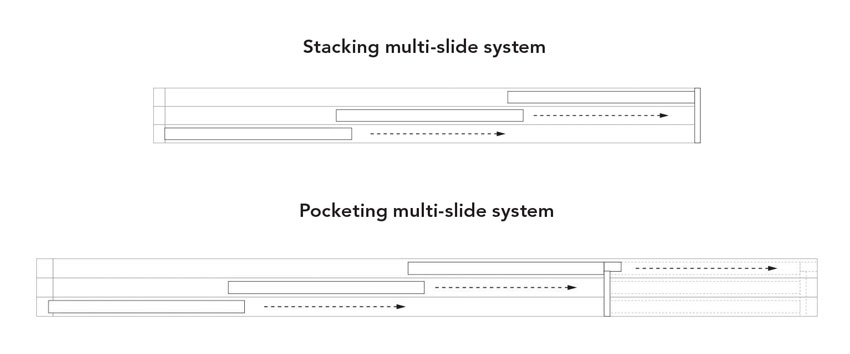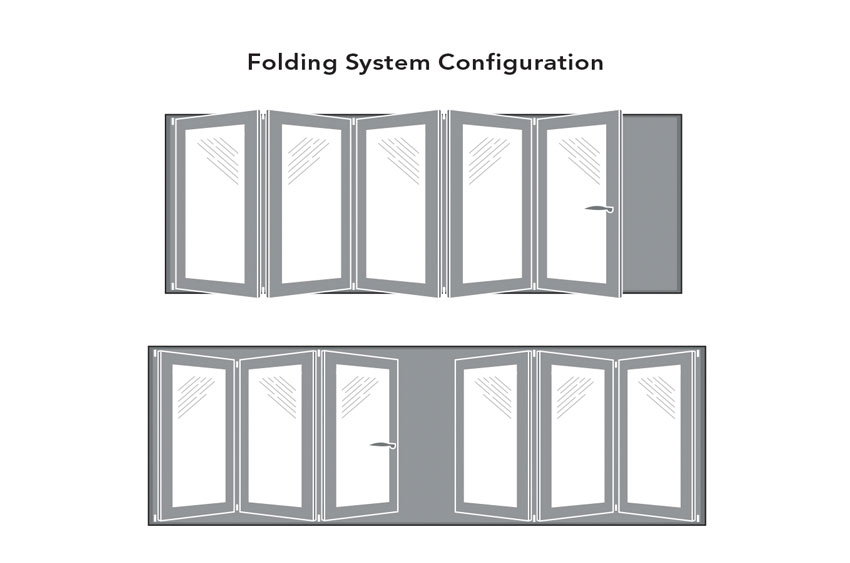Crafting the Intersection Between Indoors and Outdoors
Meet the Family: An Introduction to Types of Multi-Panel Door Systems
Multi-panel door systems are, as the name describes, composed of multiple panels. The ways in which these panels operate defines the type of system. The most common types of multi-panel door systems are folding and multi-slide. Multi-slide doors may be further separated into stacking multi-slide or pocketing multi-slide.
Multi-Slide Doors
In a multi-slide door, panels stack within the opening.
Multi-slide glass doors are generally used to create large openings in walls or to take the place of an exterior wall altogether. The size of the panels and the total door unit can vary and may be custom fabricated to suit a particular building project. Usually, it is the glass itself that imposes limits on the size of each individual multi-slide panel. Most single pieces of glass are limited to 60 square feet in size, with a typical maximum height of 12 feet and a width of 8 feet. The number of individual panels can be varied to meet the desired opening dimensions.
The configuration of multi-slide door panels can be designed so that all panels stack behind each other on one side of the opening, or so that panels are split to stack on both sides of the opening. There are two basic options for how the individual panels appear when stacked. The first option is to keep one glass panel fixed, or stationary, and to slide all adjacent panels to stack evenly behind this stationary panel. In using this option, when fully stacked, some manufactured designs appear as a single panel when viewed from the inside or outside. The second option is to conceal the sliding panels in a wall pocket when open. In this style, the sliding panels disappear altogether, giving the appearance of a full opening in an otherwise solid wall area.
Multi-slide doors do not need to be limited to a single wall plane. Manufacturers have developed methods to allow doors to meet at a corner location, eliminating the need for a post or frame element. When open, the corner virtually disappears, allowing a full visual and physical three-dimensional connection between outdoors and inside. When fully closed, the door panels come together to form the corner.

Image courtesy of LaCantina Doors
Multi-slide doors are classified by their different operation methods: stacking multi-slide doors and pocketing multi-slide doors.
Folding Doors
In a folding multi-panel door system, panels stack perpendicular to the opening when fully opened. As with multi-slide systems, in folding systems, doors may stack to one side when open, or can divide and stack to both sides of the opening. The folding action mimics the expansion and contraction of an accordion. The panels may be inswing or outswing, depending on design preference and use. Because of the weight of the system, individual folding door panels are typically limited to 39 inches in width; standard heights may be 7 to 8 feet tall or can be made to measure up to 10 feet tall. Despite those limitations, openings for a full system of folding doors can reach up to a staggering 65 feet wide.
Folding glass doors may either be floor-mounted or top-hung, with top-hung systems the predominant method. In a top hung folding door system, the top track carries the weight of the doors and the floor track serves as a guide. Precision bearings and rolling hardware are used to operate the door. Top-hung systems allow for effortless and smoother operation and longer lifespans. The frame must be secured to an adequate header that does not deflect downward when the doors are installed. The structural support required and header size depends both on the weight of the doors and the surrounding structural conditions.

Image courtesy of LaCantina Doors
Daily access door on any configuration that includes an odd number of panels.









